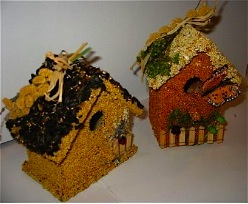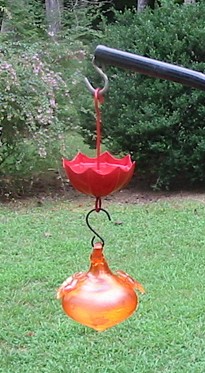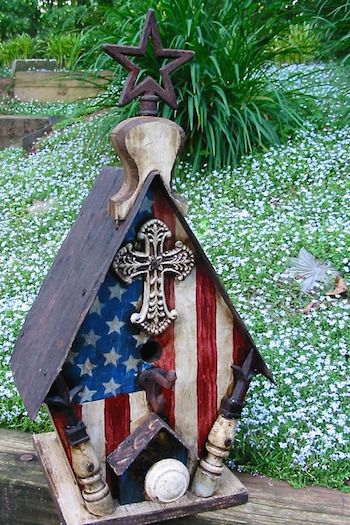-
Decorative Bird Houses and Freedom for All
Aside from gatherings and bar-b-ques, Memorial Day is a good time to reflect on the freedom we take for granted. Pause for a minute today and think about all those who’ve sacrificed for that freedom we enjoy.
Pretty much free to do as we please on our own property, gardening, birds and outdoor living spaces are bigger (and better) than ever! Decorative birdhouses not only offer refuge for birds, they can spruce up the landscape and turn a boring spot exciting. If you’re lucky enough to have a pair of nesting birds, watching them fledge can be thrilling.
Please, please, do not offer a house with a huge gaping entry as it will attract the wrong birds. Are we bird snobs? Heck no, all the usual suspects gather at our place. By “wrong birds” we’re talking the less desirable, non-native species who threaten our native cavity nesters like bluebirds, tree swallows, purple martins and others. These birds are protected under the Migratory Bird Treaty Act, and European starlings and English house sparrows threaten their existence daily.
Ask any martin or bluebird landlord about the horrors of these invasive birds, they actively trap starlings and house sparrows in order for blues and martins to thrive… its the only way, and yes it is legal. If you do a quick search on either of these non-native species, you’ll find blood-curdling stories and some very disturbing images of the havoc they wreak on bluebirds, martins and others. We won’t go into detail here as you’ll see for yourself. And the mess? For heaven’s sake, there’s no nastier bird out there than a starling! This is why several manufactures offer traps specifically for these two species. Sparrow and starling traps are quite popular among anyone hosting a martin colony or bluebirds!
With an innate sense to reproduce, they kill and maim to access nesting space. So this is where freedom to put up any old decorative birdhouses comes into play. If you have one of those cute styles from the fair, or something a bit whimsical from the craft store- it’s perfectly okay. Just be sure the entry is proportional for the birds you’d like to attract. No gaping huge holes as they entice starlings to nest. The entry should never be at the very bottom of the house either, it makes nestlings easy prey for a slew of predators.
Yes the holiday weekend is a time to reflect on freedom, please give native songbirds the freedom to nest and raise their young in peace. Because enough predators already exist, and real-estate is scarce out there, offer proper housing for nesting and don’t encourage these non-native birds to your place!
-
Fun Teacher’s Gift: Edible Birdie Cottages are Wood Birdhouses
 Need a clever and fun gift for teachers? Something that’s functional is always a good bet, and if he/she happens to be a nature buff, birdie cottages are perfect!
Need a clever and fun gift for teachers? Something that’s functional is always a good bet, and if he/she happens to be a nature buff, birdie cottages are perfect!Wrapped in clear cellophane, they make for a great presentation when topped with a simple bow. In sets of two’s, one buy gets two teachers, with something unique and actually usable!
Handcrafted in the USA, real wood birdhouses are used below the premium seed. Songbirds love them now as feeders and later as houses and roosting spots. The larger version is a super cool full-size wren house (All-Seasons Casita) and both are on sale now.

Think outside the box this year for a special teacher who’s put forth extra effort inspiring students. Gifts like these are for now and later and do keep on giving… back to the birds 🙂
-
The Ant Moat Accessory for All Sweet Feeding
 Not just for hummingbird feeders, the all-important ant moat will protect nectar in butterfly and oriole feeders, they’re ideal for jelly feeders too! Ants adore sweet sticky anything, so as long as there’s a hanger, you can use an ant moat. It just comes between the feeder itself and the hook from where said feeder will hang.
Not just for hummingbird feeders, the all-important ant moat will protect nectar in butterfly and oriole feeders, they’re ideal for jelly feeders too! Ants adore sweet sticky anything, so as long as there’s a hanger, you can use an ant moat. It just comes between the feeder itself and the hook from where said feeder will hang.Because ants can’t swim, the water inside the moat keeps them from reaching nectar. The pesky things must exude something quite distasteful as one single ant ruins a whole batch of nectar in the feeder, hummingbirds won’t touch it!
Basic colors are red, black, clear and orange for orioles. Some oriole and hummingbird feeders offer built-in moats, but they must be maintained and filled with water to serve their purpose. Let the moat run dry and like magic… ants will appear if they’re anywhere in close proximity.
Here’s a great “how to” video to make your own ant moat. So if you’re the crafty type, and have the time and patience to do these kind of projects, check this video, and ants be gone for good!
https://www.facebook.com/teresa.crain.94/videos/10152707295271986/?pnref=story

